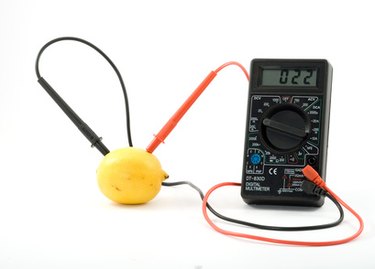Things You'll Need
Masking tape
Pencil
Needle-nose pliers
Screwdriver with insulated handle

A capacitor contains two metal plates surrounded by insulation, called dielectric. Applying voltage to the capacitor's wire terminals charges the plates. The capacitor then stores the charge until the appliance the capacitor supplies power to needs it. Testing a capacitor with an ohmmeter can determine what the resistance is between the capacitor's plates and whether the capacitor has shorted. Some capacitors actually contain two capacitors in one housing, called dual- or combination-capacitors, and help operate two devices. Dual-capacitors, commonly found in an air-conditioning system's condensing unit, have three wire terminals: one common and one for each device.
Step 1
Disconnect the capacitor's power source. If the appliance the capacitor operates in plugs into a wall receptacle, unplug the appliance. If the appliance the capacitor operates in hard wires into a circuit breaker, turn off the appropriate circuit breaker.
Video of the Day
Step 2
Label the wires connecting to the capacitor with masking tape. Some capacitors have terminal labels printed on the capacitor's lid or housing. Capacitors without labels have non-polarized terminals and do not need labels.
Step 3
Pull the wire's terminal connectors off of the capacitor's wire terminals with needle-nose pliers. Grab the terminal connector with the pliers and pull the terminal connector straight off the terminal. Do not pull on the wire with the pliers.
Step 4
Hold a screwdriver with an insulated handle across the capacitors terminals. The metal part of the screwdriver must touch both terminals at the same time. This discharges the capacitor's charge. If testing a dual-capacitor, hold the screwdriver on the terminal labeled "COM" and touch the other terminals with the screwdriver independently.
Step 5
Turn an analog ohmmeter to its highest setting. Touch its leads together and zero the meter. Notice the meter's needle move to an infinite reading.
Step 6
Place the ohmmeter's negative (black) lead on a capacitor terminal. If the capacitor has polarized terminals, place the negative lead on the terminal with the negative (-) symbol. If testing a dual-capacitor, place the negative lead on the "COM" terminal.
Step 7
Place the positive ohmmeter lead on the remaining capacitor terminal and watch the ohmmeter's reading. The capacitor passes the ohmmeter test if the needle moves to infinite, retreats slightly and then goes back to infinite. The capacitor fails if the needle does not move or if the needle points at infinite and stays there. If testing a dual-capacitor, test the second positive terminal the same way.
Video of the Day